Kommentarer överflödiga….
Tag: tsunami
We are now over 3 months into the Fukushima accident, progress is creeping along at a steady pace. Since our last update there has been lots and lots of new and I won’t try to cover it all. The biggest news I want to share now is that TEPCO has gotten some kind of recirculation cooling working, it was reported today by Will Davis at Atomic Power Review(by far the best blog to keep an eye on for Fukushima news, I highly recommend to read it).
In short water is leaking out of the containment buildings into the turbine buildings, the water is pumped from the turbine buildings into the water treatment facility, then from there its pumped back into the reactor. Its like I described in the last update on may 18th (shown on the picture below) and one of the steps in the plan TEPCO released that month.
If everything goes well now the volumes of contaminated water will start to creep down, a proper toast is in order!
Another fairly recent news is that NRC announced that the spent fuel pools in Fukushima never went dry. That really calls into question Chairman Jaszco’s recommendation for a larger evacuation zone for american citizens in Japan than what the Japanese authorities had decided.
There has also been a lot of bullshit flying around about the situation in Fort Calhoun due to the river flooding around the nuclear power plant. Claims about goverment cover ups, Russian authorities warning about disaster etc. I haven’t bothered to look more in detail into it yet, but so far the reactor has both working diesels and connection to the external grid and quite a bit of margin before the river even comes near to flood over the flood protections. Here is a good post by Neutron Economy about the situation.
Why I’m not worrying about Fort Calhoun (and you shouldn’t either)
Links(English)
Rod Adams Ted Rockwell – Fukushima: It’s Not About Radiation, It’s About Tsunamis
NEI Nuclear Notes Friday Update
World Nuclear News Fukushima cover on its way
The Neutron Economy Expected Doses Over a Year and Evacuation of Fukushima Towns
Will Davis How the Misinformation Superhighway affects Nuclear Energy
Will Davis JAIF Public Opinion Poll Data
Links(Swedish)
Med örat mot rälsen Kärnkraften igen
Kultur Ska vi glömma Fukushima?
Seppo Laine Mycket värre än man kunde tro
Status for each reactor
/Johan
4 CommentsThis is not so much an April Fools joke as it is a little riddle. It connects to a current event… and to things that happened in the last century. And of course it has something to do with nuclear power.
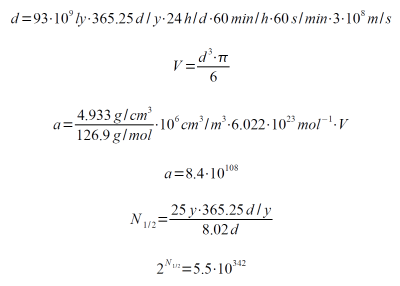
This is a comparison between two estimated values… what are they?
Update: we have a winner! Tony scored a perfect bullseye. I’m quoting him here:
‘a’ is the number of iodine atoms that would fill the known universe, if the iodine were at ‘normal’ temperature/pressure.
the second number is the number of radioactive iodine atoms you would have needed, when Chernobyl exploded, in order to have one radioactive iodine atom left today.
An added trivia is that the estimated number of atoms in the known universe is approximately 10^80.
The upshot of all this is this: there is not a single atom of Iodine-131 released by Chernobyl in existence today. The last atom decayed in no more than 4 years after the accident.
/Michael
4 CommentsUpdate 23:20(CET)/21:20(UTC)/06:20(JST)
NISA has not released any new update today, JAIF has released one more update since this morning. I won’t paste updated tables this time, but they can be seen in the link provided. There is no major changes to any reactor. Both number 2 and number 3 reactors are now getting their freshwater pumped with temporary electric pumps that have replaced the fire pumps used up untill now. In their latest written report they say that they have found highly contaminated water in a tunnel with pipes and cables connected to the turbine hall, the activity level is similar to the water found in the turbine hall basement and they are investigating the source of the water. They continue to se high levels of, among other things, I-131 in the seawater and suspect it is due to the contamination in the tunnel.
Kyodo reports that plutonium has been found in the soil outside the reactors. The source of the plutonium is unknown and the level is comparable to what was found in japan after the nuclear tests done by Russia and the US during the cold war. TEPCO has provided a report that gives the concentration as about 1 Bq/kg of soil of Pu-239 and less than 0.5 Bq/kg of soil of Pu-238. The levels are very low and one could practically eat tons of soil before ingesting getting a dangerous amount. There is 0.44 billionths of a gram of Pu-239 per kg of soil*, a lethal dose of plutonium-239 is half a gram. So one would have to eat more than one million metric tons of soil to get a lethal dose of the plutonium contained within the soil. That is how low the amount is (that also gives a good example how exceptionally low concentrations of radioactive materials can be detected).
NHK reports that the 3 exposed workers have been sent home and that they don’t show any symptoms of radiation sickness.
It seems like the number 2 reactor is leaking quite significant amounts of radioactive water. It’s not clear if it is coming through a breach in the containment or if it is through some of the pipes. If for instance the valves, closing the reactor from the pipes that are coming in through the containment, is leaking. The highly radioactive water is a big problem since it prevents access to the turbine halls and delays work to restore the reactors internal coolant pumps. They have found similar build ups of radioactive water in the number 1 and 3 reactors turbine halls, but not as strongly radioactive. Since it is a problem in all three reactors to some extent my bet would be that it is the valves that are leaking.
Update 09:30(CET)/07:30(UTC)/06:30(JST)
JAIF has released their update but not NISA. I will wait to write down the status of the reactors until the NISA update arrives and for now I just paste JAIF’s tabels.
Kyodo reports that TEPCO measured the radionuclide content of the water in the turbine halls wrongly, they overestimated it by a factor of a hundred. Confirming our suspicion that they are measuring wrong. Kyodo also reports that the Nuclear Safety Comission states that there has been a partial meltdown in the number 2 reactor. I am a bit surprised by this statement because it has been quite clear since the first few days that there has been a partial meltdown.
The workers that where exposed to radiation while working in the turbine hall basement have left the hospital and are reportedly in perfect health.
According to TEPCO’s latest update they have switched the cooling of the number 2 reactor from the fire pumps to temporary electric pumps.
Reuters report that the levels of radioactive material in the sea outside the plant is dropping.
Links(english)
Kyodo FOCUS: Little sense of crisis over tsunami in Japan’s nuclear power industry
Reuters Japan raps nuclear operator over radiation mistake
Links(swedish)
DN larm om hög strålning var fel
DN samtidigt ökar oron för Fukushima
Aftonbladet strålningslarmet var ett misstag
Expressen Härdsmälta i kraftverket
Two days ago we first got the report that there is highly radioactive water in the turbine building basement of reactor 1. NISA released this list of isotopes found in the water and its activity per cubic centimeter. I added half lives to the list to make it more understandable.
| nuclide | activity(Bq/cm³) | half life | Q value (keV) |
| Cl-38 | 1,60E+006 | 37,24 min | 4916,53 |
| As-74 | 3,90E+002 | 17,77 days | 2151 |
| Y-91 | 5,20E+004 | 58,51 days | 1544,82 |
| I-131 | 2,10E+005 | 8,025 days | 970,86 |
| Cs-134 | 1,60E+005 | 2,065 days | 1233,38 |
| Cs-136 | 1,70E+004 | 13,04 days | 2548,22 |
| Cs-137 | 1,80E+006 | 30,08 years | 1175,63 |
| La-140 | 3,40E+002 | 1,679 days | 3762,22 |
We see that there is one peculiar things, a high activity of Chloride-38. The only way for Chloride-38 to be created is by Chloride-37 in seawater absorbing a neutron and turning into Cl-38. This would indicate there is still a considerable neutron flux in the core. Forum discussions have been going on about it. The other peculiar thing is the activity levels, the activity per cm³ is just crazily high. I suspect they are really measuring activity per liter and mistakenly report it as cubic centimeter and I will give 2 arguments for that.
1. The activity of the water
They reported that 3 workers had been working in the water for more than an hour, their dosimeters showed a dosage close to 200 mSv and two of the workers didn’t wear rubber boots so they got a large surface dose on their ankles and feet from beta radiation(some reports say up to 6 gray). But this does not match with the activity levels seen in the table I pasted above. If one multiplies the activity in Bq/cm³ with the Q value, i.e the energy released in the decay of one atom, and massage the numbers a bit to get the numbers in joules instead of keV and in cubic meters instead of cubic centimeters. Then one finds that the water is putting out 1.68 Watts per cubic meter of water. Something like 20% of that energy is from gamma rays, the rest is beta rays and recoil energy in the decaying nuclei.
1.68 Watts doesn’t sound like a lot given that a normal water kettle can have a power of 1000 W. But in terms of ionizing radiation 1.68 W is just crazy. Radiation dose is measured in Grays, one Gray is equal to one joule absorbed by one kg of tissue and a Watt is as we know one Joule per second. A one Gray whole body dosage is enough to get radiation sickness, 10 Grays will kill you slowly(over a few days) and 100 Grays kills you instantly.
These workers where working in water that is putting out watts of radiation, that means they should have gotten hundreds of Grays in an hour. It was stated they where knee deep in this water! Now if we instead consider that perhaps they mean activity per liter, misstakenly reported as cubic centimeters, then everything goes down by a factor of 1000(there are one thousand cubic centimeters in a liter). Instead of hundreds of Gray the workers would have gotten hundres of milligray, that is consistent with their dosimeter readings.
2. The neutron flux needed to create Cl-38
The probability that a Cl-37 atom will absorb a neutron and turn into Cl-38 is quite low, 1 barn(this probability is measured in a unit called barns, one barn=10^-24 cm², uranium has as comparison a fission probability of about 600 barns). So one needs a lot of neutrons to create any significant quantity of Cl-38. If one assumes the water concentration of Cl-38 has dropped by a factor 1000 when traveling from the reactor vessel to the water in the turbine hall basement(dilution, decay etc). Then one can make a rough approximation of the neutron flux needed in the core in order to create the Cl-38 concentration seen in the turbine hall(technically solving the Bateman equation for a equilibrium case with one group cross sections).
Neutron flux ends up being around 10¹² neutrons per square centimeter and second. A reactor running at full power produces on the order of 10^14 n/cm²*s. The core would have to be running at about 1% of its full power(10-20 MW thermal) to produce that flux, but I might as well be off by a factor of 10 in my estimate of dilution, which would put the power in the rage from 1-100 MW. We can exclude 100 MW since we have not seen a pressure and temperature spike that high in reactor number 1. We can not exclude 1-10 MW power levels because it is on the same order as the decay energy. But if we also again here assume they mean Bq/liter instead of Bq/cm³ then the needed flux to produce the Cl-38 goes down to something around 1*10^9 neutrons/cm²*s. That kind of neutron flux could plausibly be around from radioactive decay or a very very low power level.
Those 2 factors together makes me believe they are reporting activity levels wrongly. Lets see if I will have to change my opinion when new information arrives.
Notes for the interested.
To convert from the unit eV(electron volt) to joule one multiplies 1 eV with 1.602*10^-19
The Bateman equation describes the time dependent concentration of radionuclides. For the case of a nuclide created by a neutron flux and destroyed by decay one gets this equation
dN/dT= N_37*sigma_37*flux – N_38*lambda_38
Where:
N_37=number of Cl37 atoms per cubic centimeter(I assumed saturated salt water at 100 degres, which gives 0.39 grams of salt per cm² which gives 9,74*10^20 Cl37 atoms per cm³)
sigma_37=neutron capture cross section, around 1*10^-24 cm²
flux=neutron flux in neutrons per cm² and second
N_38= Number of Cl-38 atoms per cm³.
lambda_38 = decay constant for Cl-38(equals to Ln(2)/half life)
If one assumes equilibrium then dN/dT=0 and one gets that
flux=N_38*lambda_38/(N_37*sigma_37)
One get N_38 from dividing activity with decay constant and then multiplying by a dilution factor.
Here are all the numbers I plugged in in case someone can spot an error.
| Find flux | |||||
| Avogadros number | 6,02E+023 | ||||
| Salt density(gram per cm3) | 3,90E-001 | Dilution factor(from vessel to puddle) | 1000 | ||
| Molar mass sodium | 2,30E+001 | Cl37 capture cross section | 1,00E-024 | ||
| Molar mass chlorine | 3,55E+001 | Cl37 number density (per cm³) | 9,74E+020 | ||
| Moles of NaCl | 6,67E-003 | Cl38 lambda | 3,10E-004 | ||
| Fraction Cl-37 | 2,42E-001 | Cl38 number density (per cm³) | 5,16E+009 | ||
| Moles Cl-37 | 1,62E-003 | ||||
| Number of Cl-37 per cm³ | 9,74E+020 | Flux | 1,64E+012 | ||
Links(english)
Kyodo News Woes deepen over radioactive waters at nuke plant, sea contamination
Reuters Soaring radioactivity deals blow to Japan’s plant
BBC Radiation soars at japan reactor
NHK extreme radiation detected at number 2 reactor
Links(swedish):
DN Arbetare evakueras efter akut strålning
SvD Fler svenskar misstror kärnkraft
SVD Nya bakslag vid Fukushima
Aftonbladet tio miljoner gånger högre strålning
Röda berget
Jinge
In your face
Kunskapssamhället
Svensson
Uppdate 20:00(UTC)/22:00(CET)/05:00(JST)
Reactor 1:
Water level in the core: 1.65 (1.65) meters below the top of fuel assemblies
Flow rate of injected water: 120 liter/minute
Core pressure: 508(517) kPa
Containment pressure: 270(270) kPa
Core temperature(feedwater nozzle): 224.8 Celsius
Core temperature(bottom head): 143.4 Celsius
Dose rate within containment: 34.6 Sv/hour
Reactor 2:
Water level in the core: 1.2 (1.2) meters below the top of fuel assemblies
Flow rate of injected water: 270-280 liter/minute
Core pressure: unknown
Containment pressure: 110 (110) kPa
Core temperature(feedwater nozzle): 123.6 Celsius
Core temperature(bottom head): 111.2 Celsius
Dose rate within containment: 41.6 Sv/hour
Spent fuel pool temperature: 67 Celsius
Reactor 3:
Water level in the core: 2.3 meters below the top of fuel assemblies
Flow rate of injected water: 220 liters/minute
Core pressure: 130 (133) kPa
Containment pressure: 107.3 (107.6) kPa
Core temperature(feedwater nozzle): 13.6 Celsius (obviously error)
Core temperature(bottom head): 121.6 Celsius
Dose rate within containment: 33.7 Sv/hour
No major changes to the status of the reactors. Pressure in all containments seem ok. There is total confusion regarding the measured isotopes in the water in the basements for the turbine halls. It seems impossible to sort it out in any way and we can only wait for TEPCO or NISA to give final word on what they are actually measuring. It is pretty much beyond a doubt that the activities they published yesterday are wrong, it isn’t consistent with the given dose rates.
Update 10:00 (UTC) / 12:00 (CEST) / 19:00 (JST)
No new update from NISA during the night, but a new update from JAIF(link 1, link 2).
Reactor 1:
Water level in the core: 1.65 meters below the top of fuel assemblies
Flow rate of injected water: no new data
Core pressure: 508 kPa
Containment pressure: 270 kPa
Core temperature(feedwater nozzle): no new data
Core temperature(bottom head): no new data
Dose rate within containment: no new data
Reactor 2:
Water level in the core: 1.2 meters below the top of fuel assemblies
Flow rate of injected water: no new data
Core pressure: unknown
Containment pressure: 110 kPa
Core temperature(feedwater nozzle): no new data
Core temperature(bottom head): no new data
Dose rate within containment: no new data
Spent fuel pool temperature: no new data
Reactor 3:
Water level in the core: 2.3 meters below the top of fuel assemblies
Flow rate of injected water: no new data
Core pressure: 130 kPa
Containment pressure: 107.3 kPa
Core temperature(feedwater nozzle): no new data
Core temperature(bottom head): no new data
Dose rate within containment: no new data
Acording to TEPCO the dose rates from the water found in the turbin hall basement:
Reactor 1: 60 mSv/hour
Reactor 2: More than 1000 mSv/hour
Reactor 3. 750 mSv/hour
They have started to drain the water so that work can proceed to restore the pumps.
Links(english)
Kyodo News Woes deepen over radioactive waters at nuke plant, sea contamination
Reuters Soaring radioactivity deals blow to Japan’s plant
BBC Radiation soars at japan reactor
NHK extreme radiation detected at number 2 reactor
Links(swedish):
DN Arbetare evakueras efter akut strålning
SvD Fler svenskar misstror kärnkraft
SVD Nya bakslag vid Fukushima
Aftonbladet tio miljoner gånger högre strålning
Röda berget
Jinge
In your face
There is a new website where you can see answers about the Fukushima events.
http://fukushima-answers.com/
Don’t fear the unknown. Ask!
Anxiety, fear, panic or resignation and passiveness . That’s what many people experience under the current overload of information spread by media and various interest groups. We believe that a sound mind doesn’t need other people to tell it what to think, what to fear or what to trust. It needs clear facts.Here you can find explanations in plain language from nuclear professionals . Ask questions, learn the facts and form your own opinion.
3 CommentsUpdate 15:00(UTC)/16:00(CET)/00:00(JST)
NISA has released their update, link 1, link 2, link 3. I have also reattached the earlier JAIF figures at the bottom of the last update to see if it will fix the bug that gives an error when one clicks on the pictures.
As usual the NISA figures are between (). The NISA data is 3 hours older than the JAIF data.
Reactor 1:
Water level in the core: 1.65(1.65) meters below the top of fuel assemblies
Flow rate of injected water: 7.2 cubic meters per hour
Core pressure: 476 (477) kPa
Containment pressure: 270 (270) kPa *note, in the last update I misstakenly wrote 370 kPa as containment pressure.
Core temperature(feedwater nozzle): 195.3 Celsius
Core temperature(bottom head) 146.3 Celsius
Dose rate within containment: 35.1 Sv/hour
Reactor 2:
Water level in the core: 1.1 (1.1) meters below the top of fuel assemblies
Flow rate of injected water: 18.6 cubic meters per hour
Core pressure: unknown
Containment pressure: 116 (115) kPa
Core temperature(feedwater nozzle): 107 Celcius
Core temperature(bottom head): 100 Celsius
Dose rate within containment: 43.4 Sv/hour
Spent fuel pool temperature: 57 Celsius
Reactor 3:
Water level in the core: 2.3 meters below the top of fuel assemblies
Flow rate of injected water: 14.5 cubic meters per hour
Core pressure: 139 (139) kPa *note, I wrote the wrong pressure in the last update
Containment pressure: 106.6 (106.6) kPa
Core temperature(feedwater nozzle): 37.6 Celsius (sounds like an error on equipment)
Core temperature(bottom head): 106.1 Celsius
Dose rate within containment: 36.1 Sv/hour
Due to my error with containment pressure in the last update I withdraw my speculation that its hard to control the pressure in number 1. Rather it seems like the situation is fairly stable. Otherwise not much new information.
The US Department of Energy has done some arial surveys around Fukushima Daiichi and released the data. I have one pictures from it below(hats of to http://neutroneconomy.blogspot.com/ where I found the pictures). The dose rate unit used on the picture is millirad. 1 millirad=10 microgray =* 10 microsievert
*that equality between gray and sievert is only valid for gamma radiation. Gray measures the energy deposited while sievert is weighted in such a way that it expresses a cancer risk. For gamma the weighting factor is 1.
Update 12:00(UTC)/13:00(CET)/21:00(JST)
No NISA updates have been released yet today, JAIF has released their update as usual(one hour old as of writing this).
Reactor 1:
Water level in the core: 1.65 meters below the top of fuel assemblies
Core pressure: 476 kPa
Containment pressure: 370 kPa
Core temperature(feedwater nozzle): no new data
Core temperature(bottom head) no new data
Dose rate within containment: no new data
Reactor 2:
Water level in the core: 1.1 meters below the top of fuel assemblies
Core pressure: unknown
Containment pressure: 116 kPa
Core temperature(feedwater nozzle): no new data
Core temperature(bottom head) no new data
Dose rate within containment: no new data
Reactor 3:
Water level in the core: 2.3 meters below the top of fuel assemblies
Core pressure: 202 kPa
Containment pressure: 106.6 kPa
Core temperature(feedwater nozzle): no new data
Core temperature(bottom head) no new data
Dose rate within containment: no new data
All 3 reactors are now cooled with freshwater instead of sea water. It seems hard for them to get the pressure in the number one reactor under complete control. In JAIF’s written update they say lights are on in all control rooms now. Levels of radioactive materials in the seawater around the plant is climbing. TEPCO is releasing updates on activity in both sea and air, I have attached levels as pictures in the bottom of this update.
The ground deposits of I-131 the prefectures around Fukushima ranges from less than 1 to 16 kBq per square meter. The cesium ground deposits ranges from less than 0.1 to 1.9 kBq per square meter(here are the last 3 MEXT updates on ground deposts link 1, link 2, link 3). The data form the worst effected prefectures are however omitted, we hope MEXT will make those figures available asap! As a comparison the ground deposits of cesium due to Chernobyl ranged from a couple of hundreds to a couple of thousand kBq per square meter.
Update, March 26, 12:00 (UTC) / 13:00 (CET) / 21:00 (JST)
Not much to add today. The radiation levels in the sea outside Fukushima I are sky-high. The long term effects are hard to predict now since a sea contamination is entirly different from a land contamination, where land is basicly a 2D area, which leads to a thin and high concentration on the surface, and where rains soon concentrate the contamination to “hotspots”. The sea on the other hand is a 3D volume where currents quickly dilute any contaminant by dispersing them over very wide areas.
The JAIF updates from 10:00, 16:00 and 21:00 (JST) for March 26 are pretty much uniform. The big news is that freshwater injection to the cores of 1, 2 and 3 has started as opposed to using salty sea water. Apart from that nothing new. The radiation readings at the main gate (1 km out) has stayed at 170 μSv/h all day. The west gate read 147 μSv/h at 13:30.
NISA has not said anything new since last night.
Links(english):
BBC We should stop running away from radiation
Hufftington post US brings fresh water to japan nuclear plant
NY Times Japan presses nuclear plant repair as more damage is found
Rod Adams Shaken, flooded, stressed by power outages, Fukushima Daiichi moves into second place
The Independent Fear and devastation on the road to Japan’s nuclear disaster zone
Links(swedish):
Röda berget
Dr Angels blog
DN Radioaktivt jod tusen gånger tillåten nivå i havet
Aftonbladet Strålningen ökar runt Fukushima
SvD Radioaktivt vatten i reaktorer
Tänkvärt? Eller inte!
Grön horizont
17 Comments
Uppdate 22:45(UTC) / 23:450(CET) / 07:45(JST)
There has been no further info yet on the status of the exposed workers or the status of the reactors. Only news about the reactors is that both number 1 and number 3 have now switched to fresh water injection into the core and number 2 was supposed to follow promptly. I end todays updates with a few video clips of the explosion in one of the refineries that was hit worst by the earthquake and tsunami. This disaster has struck so many lifes, so many industries and so many towns that it is hard to fathom.
Uppdate 16:30(UTC) / 17:30(CET) / 00:30(JST)
The 2 workes taken to hospital reportedly got a dose to their feet and lower legs between 2-6 Sieverts from beta radiation. They also got close to 200 mSv from gamma and an unknown internal dose.
They have not shown any signs of acute radiation sickness so far. But the dose to the legs are very worrying and in the worst case might mean amputation.
Update 14:15 (UTC) / 13:15 (CET) / 22:15 (JST)
New updates from JAIF and NISA(link 1, link 2, link3). JAIF status is from 15:00 JST and NISA updates from 10:00 and 12:30 JST. As before the first number is from the JAIF update and the number within () is from the older NISA update.
Reactor 1:
Water level in the core: 1.65 (1.65) meters below the top of fuel assemblies
Core pressure: 450 kPa (450 kPa)
Containment pressure: 295 (295) kPa
Core temperature(feedwater nozzle): 197.8 Celsius
Core temperature(bottom head) 153.6 Celsius
Dose rate within containment: 38.9 Sievert/hour
If one looks at the JAIF status updates one can see a very encouraging piece of information, they have switched from seawater to fresh water injection into the pressure vessel! That is one significant step in the direction of stabilizing the reactor since seawater injection could never be a permanent solution. They are still not using the internal pumps however. The temperature of the core seems to have been brought under control and the high containment pressure is on a slowly declining trend. We can only keep our hopes up that they will be able to avoid venting the containment.
Reactor 2:
Water level in the core: 1.20 (1.2) meters below the top of fuel assemblies
Core pressure: unknown
Containment pressure: 120 (120) kPa
Core temperature(feedwater nozzle): 107 Celsius
Core temperature(bottom head) 105 Celsius
Dose rate within containment: 45.6 Sievert/hour
Reactor 3.
Water level in the core: 2.3 m below the top of fuel assemblies.
Core pressure: 139 (139) kPa
Containment pressure: 107 kPa
Core temperature(feedwater nozzle): 42.8 Celsius (probably junk)
Core temperature(bottom head) 111,6 Celsius
Dose rate within containment: 51 Sievert/hour
Preparations are being made to switch from seawater to fresh water for reactor 2 and 3. If it goes as quickly as for number one it should be done within half a day. Work with electrical equipment on going.
We have earlier warned for the possibility that molten material in the core can be lying on the bottom of the vessel and eating its way through, now that seems unlikely considering how low the bottom head temperatures of the vessel are. All of them are below 200 degrees.
Dose rate at main gate around 200 micro sievert per hour.
Update 12:30 (UTC) / 11:30 (CET) / 20:30 (JST)
TEPCO is preparing to switch from salt water to fresh water for the core cooling. From NHK:
TEPCO says it intends to switch over from pumping sea water to pumping fresh water into the 3 reactors, as salt in the sea water could cause corrosion and buildup, hampering the smooth flow of water inside the structures.
The company has been pumping seawater as an emergency measure.
The power company also says preparations to switch to fresh water were completed at the No.1 reactor on Friday afternoon.
Operations to pump fresh water into reactors No.2 and No 3 are expected to start later in the day.
Update 10:00 (UTC) / 11:00 (CET) / 19:00 (JST)
Here are the status tables from the JAIF update described below and summary.
Reactor 1:
Water level in the core: 1.7 meters below the top of fuel assemblies
Core pressure: 465 kPa
Containment pressure: 310 kPa
Core temperature(feedwater nozzle): no new info yet today
Dose rate within containment: no new info yet today
Pressure has decreased by about 60-80 kPa in both vessel and containment since yesterday.
Reactor 2:
Water level in the core: 1.10 meters below the top of fuel assemblies
Core pressure: unknown
Containment pressure: 120 kPa
Core temperature (feedwater nozzle): no new info yet today
Dose rate within containment: no new info yet today
Reactor 3.
Water level in the core: 2.3 m below the top of fuel assemblies.
Core pressure: 139 kPa
Containment pressure: 107 kPa
Core temperature (bottom head): no new info yet today
Dose rate within containment: no new info yet today
Containment damage is again suspected on number 3, otherwise no major changes since yesterday. Let’s hope the containment is not damaged! Luckily the reactors in the possibly damaged containments are behaving more stable than the number one reactor (that has a undamaged containment).
Picture of reactor number 3 building

Update 08:45 (UTC) / 09:45 (CET) / 17:45 (JST)
The 16:00 JAIF update for March 25 has been published. Two changes:
…so far seventeen workers have been exposed to more than 100 mSv of radiation.
100 mSv is the limit where an increase in cancer risk has been proven. At 100 mSv, the lifetime risk of getting cancer increases from about 25-32% to 29-36%.
Keep in mind that this does not say whether or not any of these workers will actually get any cancer, much less die from it. It is safe to assume that just as after Hirosima/Nagasaki, the medical authorities will keep those exposed under very close watch, meaning their chances of getting diagnosed early and thus surviving any cancer will be quite good.
The other change is that the radiation reading at the main gate has gone up again:
The Main Gate: 259.0μSv/h at 11:00, Mar. 25
The pressure in the #1 containment vessel is moving up and down. #2 is stable. The #3 pressure is slowly decreasing. With the worries of a leak from #3, this may have more than one explanation, not all of them good.
Update 07:20 (UTC) / 08:20 (CET) / 16:20 (JST)
The 10:00 (JST) JAIF update for March 25 has the following new entries:
Monitoring results of seawater sampled at the coast near the Fukushima Dai-ichi NPS on Mar. 23rd showed that radioactive Iodine, Cesium, Ruthenium, and Tellurium exceeding the regulatory limit were detected. Also, monitoring results of seawater sampled at coasts within about 16km from the Fukushima Dai-ichi NPS in Mar. 23rd showed that radioactive Iodine and Ruthenium exceeding the regulatory limit were detected.
Nuclear Safety Commission of Japan reported the result of preliminary calculation of exposure dose in the surrounding area of Fukushima Dai-ichi NPS.
The dose rate mesaured at the main gate has dropped slightly, from 209.4μSv/h at 12:00, Mar. 24 to 193.8μSv/h at 06:00, Mar. 25.
The high exposure of three workers in the number three turbine hall suggests that #3 may have a leak after all, says the government’s Nuclear and Industrial Safety Agency.
Water supplies continue to show taints of Iodine-131, but the readings fluctuate and it’s still hard to make out a general trend. Tokyo is no longer under a recommendation not to drink the tap water, but concerned citizens continue to use bottled water to some extent.
Following the latest findings, the Tokyo officials said it will no longer warn against consumption of tap water in the metropolitan area.
”I believe readings will go up and down. But even if levels exceed standards temporarily, it will be no problem as long as they stay (most of the time) within the range throughout the year,” Tokyo Gov. Shintaro Ishihara said at a news conference. ”I hope people in Tokyo would act calmly.”
Still, people in the capital area — located about 220 kilometers from the crippled Fukushima Daiichi nuclear plant — and elsewhere continued to buy up limited supplies of bottled water from shops and vending machines.
The government has asked that people in the 20-30 km zone around the crippled Fukushima plant to evacuate volontarily out of concern for supplies for daily necessities.
The Japanese government has encouraged people living within 20 to 30 kilometers of the troubled nuclear plant in Fukushima Prefecture to leave voluntarily, with concerns over access to daily necessities rather than resident safety prompting the advice, top government spokesman Yukio Edano said Friday.
Länkar:
SvD mycket troligt en läcka i 3an
Flute
Kommunisternas blogg
Martin Mobergs blogg
Röda berget
Aktieskolan
Cornucopia
Röda malmö
Divage
DN Kärnan kan vara skadad (den person som valde den här rubriken borde sluta använda google translate….)
DN cesium i grönsaker i Tokyo
Aftonbladet hotet i japan är osynligt
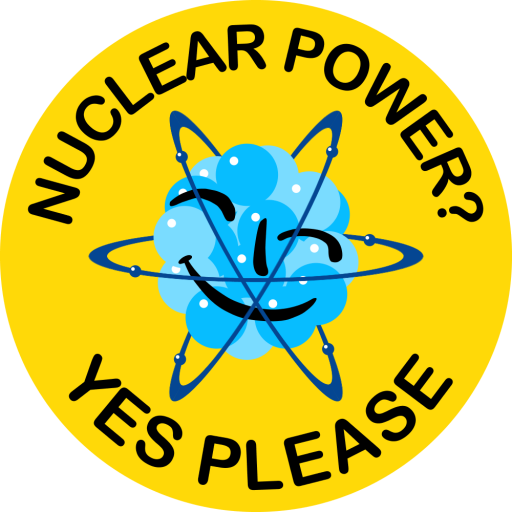

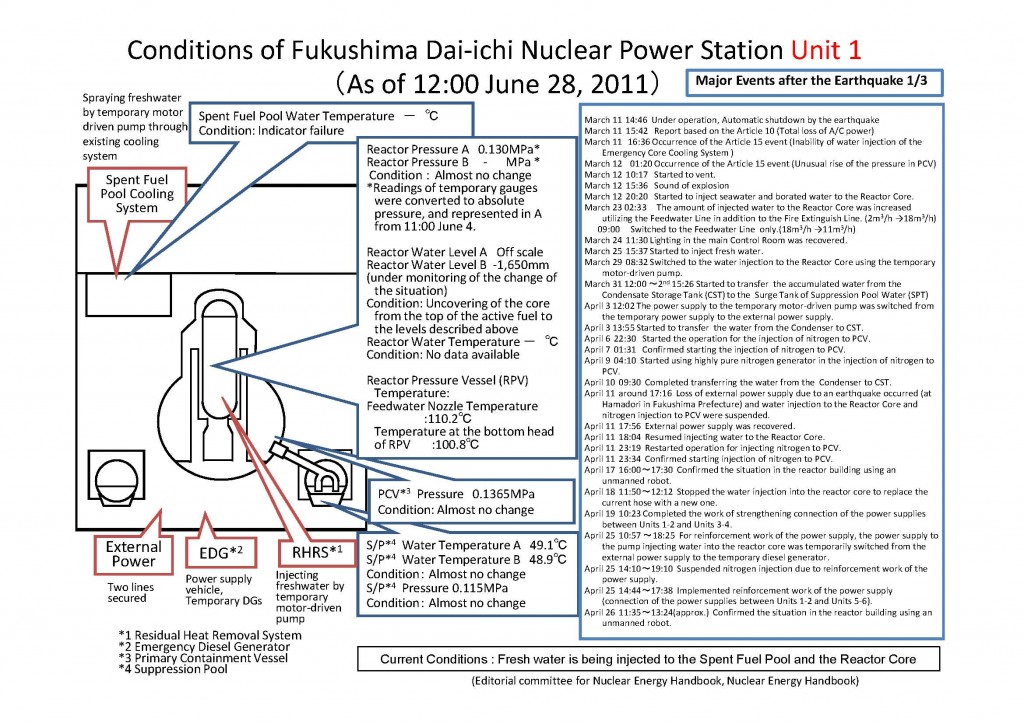
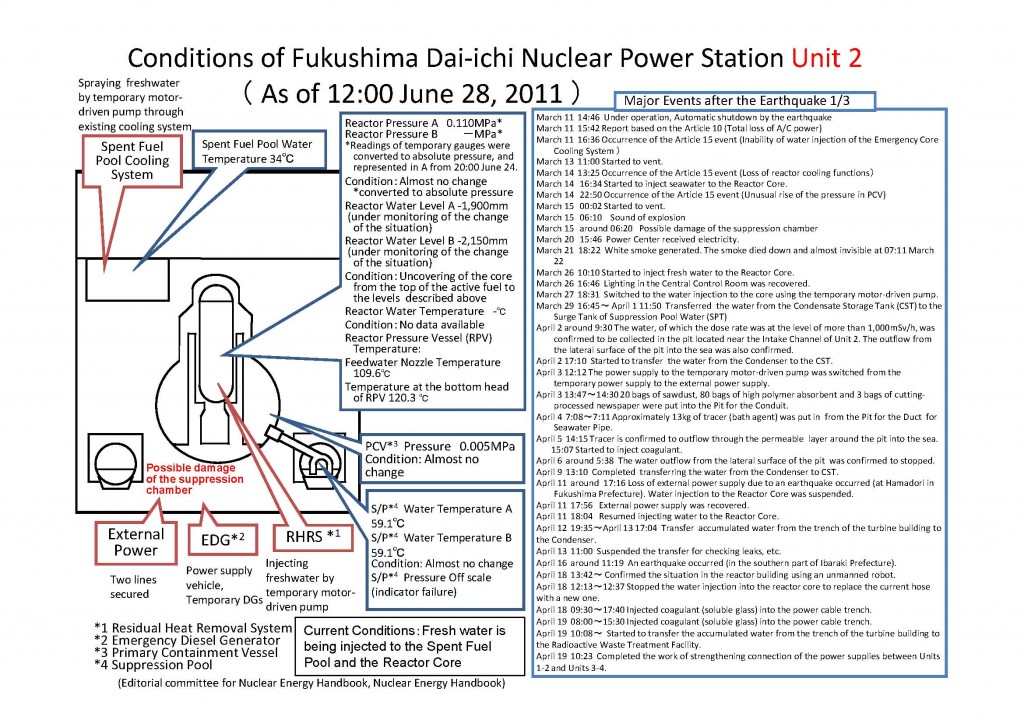
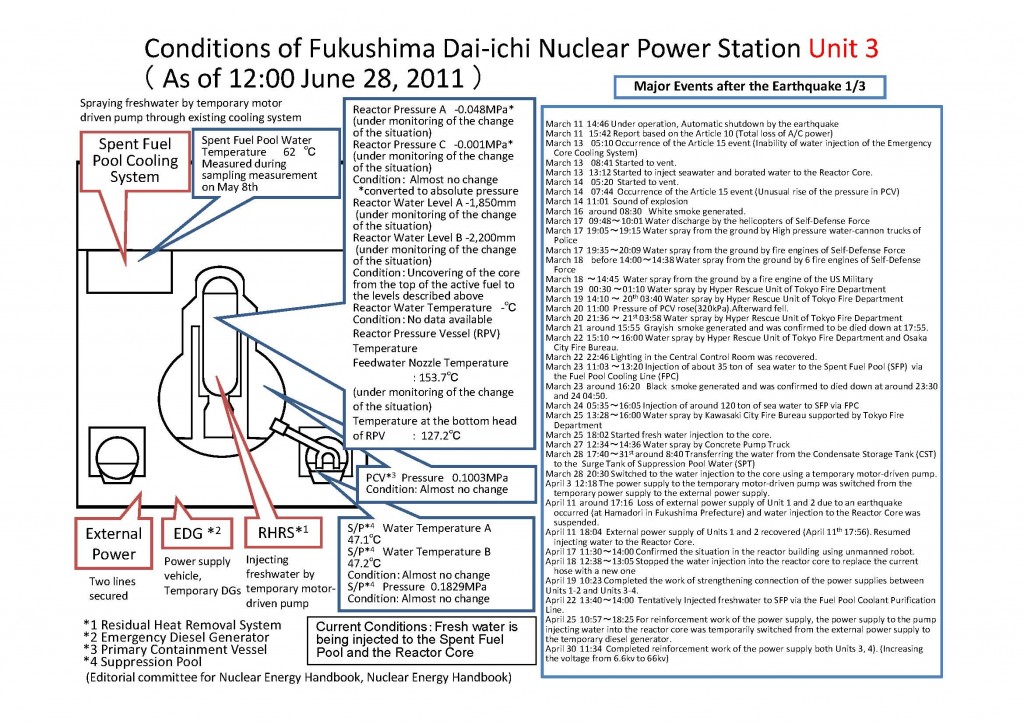


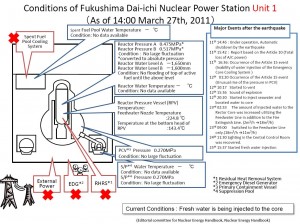
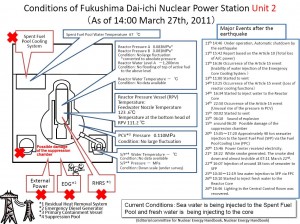

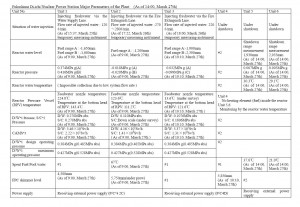
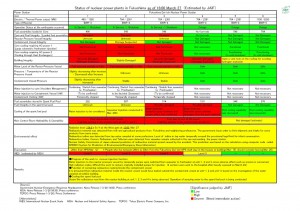
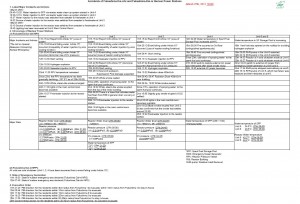



















German economy minister: “To prevent paper cuts, we must cut off our arms”
Published by Michael on April 15, 2011Ok, now it is official: Germany has gone batshit crazy.
Power firms should invest massively in coal and gas-fired power technology and renewable energy sources, Harry Voigtsberger, economy minister of Germany’s most populous state North Rhine Westphalia, said in the Financial Times Deutschland.
The original article can be read here (in german).
Angela Markel seems to be agreeing…
In a document from Friday’s meeting obtained by Reuters, Merkel and her ministers laid out a six-point plan that includes a 5 billion-euro credit programme to support renewables.
It will also require building new gas and coal plants, Merkel said. “Gas and coal power plants were discussed… an accelerated exit from nuclear energy will lead to replacement power stations,” she said.
Why? So they can get rid of nuclear power…
This is about as stupid an idea as to say that in order to prevent paper cuts to your finger you should cut off your arms!
Sure… you achieve what you aimed for… but did you really concider the side effects before you took a knife and started carving?
Diese dummen Deutschen…
13 Comments